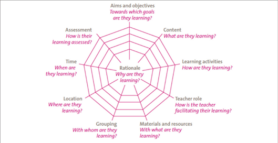Constructive Alignment
Constructive alignment is a pedagogical framework to help university educators design courses that ensure a strong connection between learning objectives, teaching and learning activities, and assessment tasks.
Origin and meaning
The principle of constructive alignment developed by John Biggs in the 1990s and remains one of the key principle for curriculum and course design to date. The name “constructive” refers to the idea that students actively construct their own understanding of the content, rather than passively receiving information. “Alignment” refers to the process of aligning course components (learning objectives, teaching methods, and assessments) to support this constructive learning (Biggs 1996; Biggs & Tang, 2011).
According to the principle of constructive alignment, learning objectives should guide the design of both teaching methods and assessment tasks. Learning objectives specify what students should know, understand, and be able to do by the end of a course. Assessments, which determine whether students meet the learning objective, should be directly linked to them, allowing students to demonstrate their understanding and competencies effectively. To support this process, learning activities—both in and out of class—should be intentionally designed to help students achieve the learning objectives (Biggs & Tang, 2011). The Teaching and Learning Collection offers a range of resources to support you in formulating learning objectives, selecting appropriate assessment methods, and designing effective learning activities.
Example of a misaligned course
Learning goal: Students will be able to analyze a scientific article (Bloom’s Level: Analyze)
- Teaching activity: Lectures on basic concepts without active engagement or critical discussion of articles.
- Assessment: A multiple-choice exam testing factual recall of terms from the article.
The teaching activity does not engage students in analyzing or critiquing the article, and the assessment focuses on recall rather than analysis. There is a disconnect between the learning goal (Bloom’s level: Analyze) and the activities and assessment (Bloom’s level: Remember and Understand).
Example of an aligned course
- Learning goal: Students will be able to evaluate the methodology used in a scientific article (Bloom’s Level: Evaluate)
- Teaching activity: Students engage in group discussions where they critically assess the methodologies of various articles.
- Assessment: An in-class exam in which students evaluate the strengths and weaknesses of the methodology of a given article.
The teaching activities (group discussions) directly support the goal of evaluation, and the assessment (in-class exam) allows students to demonstrate their ability to evaluate the methodology.
Alignment at different levels
It is also crucial to consider alignment across the entire program. This means that the goals of each lesson should align with the course objectives, and the goals of each course should align with the broader intended program outcomes. Ultimately, all sessions within a course and all courses in the program should contribute to achieving the program’s learning outcomes. At a program level, assessment across courses should demonstrate that all learning goals have been met, and the cumulative learning activities across the program should prepare students to reach those goals. In this way, lessons within a course and courses within a program should build on each other, ensuring a clear progression from foundational knowledge to advanced competencies.
Extensions of constructive alignment
The curricular spider web, developed by Dutch researcher van den Akker (2003), extends constructive alignment by incorporating the concept of layeredness described above. It visualizes the curriculum as a web, with each layer representing the interconnectedness of lessons and courses. Beyond the alignment of goals, assessment, and activities, van den Akker also includes key elements such as the philosophical purpose of learning, content, teacher roles, materials and resources, grouping, location, and time.

References
- Biggs, J. (1996). Enhancing teaching through constructive alignment. Higher Education, 32(3), 347-364.
- Biggs, J., & Tang, C. (2011). Teaching for Quality Learning at University. Open University Press.
- Van den Akker, J. (2003). Curriculum perspectives: An introduction to curriculum studies. Curriculum Innovations.
